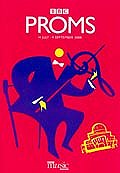 Concert Review
Concert Review
 Concert Review
Concert Review
PROM 56 Bach orch Webern 'Ricercar ' from A Musical
Offering, Mozart Piano Concerto No 25 in C, K503, Arvo Pärt Come anhela
la cierva, Dvorak Symphonic Variations, Op 78, BBC SO, conductor Jiri Belohlavek
Richard Goode, piano & Patricia Rozario,
soprano
This seemingly eclectic Prom featured a range of works encompassing the Baroque, Classical, and Romantic periods and the 20th century. If one had to state a unifying theme, it might be - at a stretch - the significance of tone colour. Webern's orchestration of Bach's 'Ricercar' is built on the principle of Klangfarbenmelodie or 'tone-colour-melody' ; in contrast, Bach's original score was 'open', with no indications of tempo, expression, dynamics or phrasing. In Pärt's cantata, contrasts of texture and colour could be said to predominate over contrasts of tempo, rhythm or harmony. And Dvorak's Symphonic Variations rely heavily on the use of texture and colour to achieve 27 distinct variations theme.
Bach based his Musical Offering on a fugue subject provided by King Frederick II; one movement, the 'Ricercar', was a six-part fugue on this theme. Webern uses Klangfarbenmelodie to emphasise the main motivic, intervallic, harmonic and formal features of Bach's work. Premièred in April 1935 by the BBC SO under the composer, the same orchestra tonight gave a keen performance with excellent solo contributions and razor-sharp ensemble as the melody was passed round the orchestra, from the chamber-music character of the opening to the full orchestral ending. Muted trumpets and a low, very well-projected violin solo (with marked 1930s-style portamento) achieved a particularly dark timbre, with the plaintive trumpet coming back to haunt us periodically.
Mozart's Piano Concerto No 25 appeared at the end of a concentrated period of composition (1784-86) in which he was at the height of his popularity in Vienna. The work's assertiveness, exemplified in its bright C major key and its grand, drum-roll-accompanied opening, its sophistication, as in the intricate thematic writing and the sheer range of expression (greater than in any other Mozart concerto first movement) have ensured the work's popularity. Richard Goode, a foremost Beethoven interpreter, brought a delectably clear, bell-like articulation and melting lyricism to the work, although overall we could have done with one degree less polish and one degree more 'affect', especially in the more tempestuous 1st-movement development section. If the orchestra's performance lacked a certain bite, they achieved a very delicate balance and precise ensemble with the piano, except for some poor co-ordination on their re-entry after the cadenza (Goode's own).
Pärt's sacred cantata Como anhela la cierva, a setting of Psalms 42 and 43, was commissioned by the 1999 Canary Islands Music Festival. It was written for tonight's soloist, the soprano Patricia Rozario, whose wide-ranging tessitura and dazzling (though not especially big) voice favour the work. A work in the 'holy minimalist' style, it is strongly rooted in diatonic tonality, with simple rhythms and harmonies, and draws its power from hypnotic, incantatory repetition. Each verse is a self-contained movement, some with haiku-like simplicity of scoring, others more elaborate; the rhythm attains its maximum propulsion at the end of Verse 6, 'Deep calleth unto deep' and another, full-voiced, brass-led climax is reached in Verse 9 ('Where is thy God?'). Even so, the work seemed to lack a tangible shape overall. Pärt uses the voice to wide-ranging effect, for example in the arresting opening, where the solo voice emits a low moan, or the slow incantation of Verse reminiscent of Desdemona's prayer in Otello. The leader, Stephen Bryant, played the various solos enchantingly.
The highlight of the concert came last. In 1877 Dvorak was challenged by a friend to write a set of variations on Já jsem huslar ('I am a fiddler'), a patriotically inspired male-voice part-song written by Dvorak that year. This seemingly unpromising theme was proved by the resulting 27 Symphonic Variations to be an entirely happy choice. The secret of the work's success lies in the fact that the theme has so many instantly recognisable 'fingerprints' that Dvorak only needed to hint at one, while varying the other musical parameters, to achieve continuity within a framework of variety; furthermore, its harmonic simplicity means it can support the most wide-ranging melodic invention. The variations are truly symphonic in that the music explores all aspects of a musical argument before moving onto another, thus giving them a logical inevitability. Jiri Belohlavek was clearly in his element here. This was a performance of tremendous exhuberance. The tempo was firm yet expansive, with an instinctive rubato. String ensemble and articulation were excellent (though there was some suspect tuning on octave leaps), the violin solos excellent and the 'dance'-variations had terrific Schmalz.
Altogether, the evening was quite a musical feast, combining common themes with a variety of styles and genres. The BBC SO were on very good form.
Sarah Dunlop
Seen&Heard is part of Music on the Web(UK) Webmaster: Len Mullenger Len@musicweb-international.com
Return to: Seen&Heard Index
 Return to:
Music on the Web
Return to:
Music on the Web